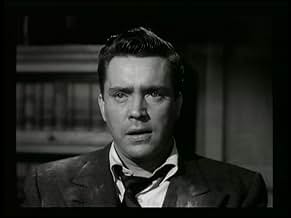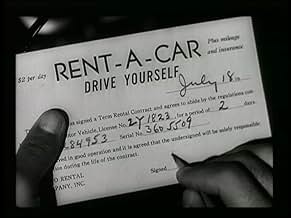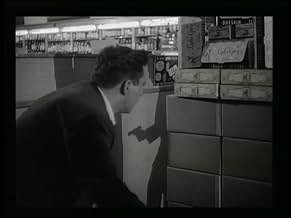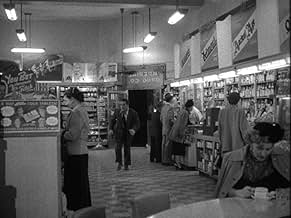Frank Bigelow, told he's been poisoned and has only a few days to live, tries to find out who killed him and why.Frank Bigelow, told he's been poisoned and has only a few days to live, tries to find out who killed him and why.Frank Bigelow, told he's been poisoned and has only a few days to live, tries to find out who killed him and why.
- Awards
- 1 win total
Beverly Garland
- Miss Foster
- (as Beverly Campbell)
Cay Forester
- Sue
- (as Cay Forrester)
Frank Jaquet
- Dr. Matson
- (as Fred Jaquet)
Lawrence Dobkin
- Dr. Schaefer
- (as Larry Dobkin)
Bill Baldwin
- St. Francis Hotel Desk Clerk
- (uncredited)
Storyline
Did you know
- TriviaThe scene in which Bigelow runs in panic through the streets after learning he has been poisoned was what is considered a 'stolen shot' where the pedestrians along the sidewalk had no idea a movie was being made and no warning that Edmond O'Brien would be plowing through them.
- GoofsAfter finding out who's in the photo, Bigelow leaves the photography studio and immediately starts getting shot at. He heads toward the factory (screen right) where the shots are supposed to be coming from, but all the shots being fired and ricocheting off the ground, pipe, barrel, etc. are coming from the other direction (screen left).
- Quotes
[first lines]
Homicide Detective: Can I help you?
Frank Bigelow: I'd like to see the man in charge.
Homicide Detective: In here...
Frank Bigelow: I want to report a murder.
Homicide Captain: Sit down. Where was this murder committed?
Frank Bigelow: San Francisco, last night.
Homicide Captain: Who was murdered?
Frank Bigelow: I was.
- Crazy creditsThe end credits read "The medical facts in this motion picture are authentic. Luminous toxin is a descriptive term for an actual poison. Technical Adviser, Edward F. Dunne, M.D."
- Alternate versionsAlso available in a colorized version.
- ConnectionsEdited into Déjà-vu (2000)
Featured review
D. O. A. is an intriguing, fast paced movie, rife with metaphor. A mood of chaos and uncertain boundaries is introduced early in the film. At a hotel in San Francisco, businessman Frank Bigelow, seeking little more than the ephemeral pleasure of a brief trip, finds himself in the midst of party revelers. With unsettling frivolity, they roam randomly about their various guest rooms which appear unlocked and opened. The mood of strident, forced conviviality climaxes when they move the party to a local bar called "The Fisherman." As the jazz played in the venue intensifies in volume and rhythm, uneven camera angles catch the various musicians playing to the point that they're breaking sweat and literally, physically vibrating. Bigelow himself is jostled about in the crowd, actually losing his footing for a moment. The setting is that of a little world both frenzied and crazed. Bigelow appears detached as all react excitedly and emotionally to music that he admits isn't his taste.
This memorable key scene portends his disconnection from those around him and represents a crack, however slight, in his life's foundation. Though initially reticent about socializing and imbibing with people he just met, he has unwittingly been thrust into a reality more threatening than is immediately apparent. Later in the film, a jarring example of his full blown isolation occurs when he finds himself in an outdoor, public area. In unbearable turmoil, he momentarily encounters a little girl innocently playing with a toy. She appears in soft lighting, contrasting starkly to the shadows surrounding Bigelow, whose face registers the painful shock of awareness that ordinary activity continues unabated even while he grapples with extreme danger. This is reinforced when seconds later he observes a young couple embracing, compounding his agonizing realization that all simple pleasures are now unattainable to him. Noticeably, when he is literally "up against the wall" his back is touching signage of "Life Magazine" logos. All that once comprised his own life, that which he had considered to be little more than mundane minutiae, is heightened in significance and irrevocably at stake.
This memorable key scene portends his disconnection from those around him and represents a crack, however slight, in his life's foundation. Though initially reticent about socializing and imbibing with people he just met, he has unwittingly been thrust into a reality more threatening than is immediately apparent. Later in the film, a jarring example of his full blown isolation occurs when he finds himself in an outdoor, public area. In unbearable turmoil, he momentarily encounters a little girl innocently playing with a toy. She appears in soft lighting, contrasting starkly to the shadows surrounding Bigelow, whose face registers the painful shock of awareness that ordinary activity continues unabated even while he grapples with extreme danger. This is reinforced when seconds later he observes a young couple embracing, compounding his agonizing realization that all simple pleasures are now unattainable to him. Noticeably, when he is literally "up against the wall" his back is touching signage of "Life Magazine" logos. All that once comprised his own life, that which he had considered to be little more than mundane minutiae, is heightened in significance and irrevocably at stake.
Details
- Release date
- Country of origin
- Language
- Also known as
- Dead on Arrival
- Filming locations
- Production companies
- See more company credits at IMDbPro
- Runtime1 hour 23 minutes
- Color
- Aspect ratio
- 1.37 : 1
Contribute to this page
Suggest an edit or add missing content






































